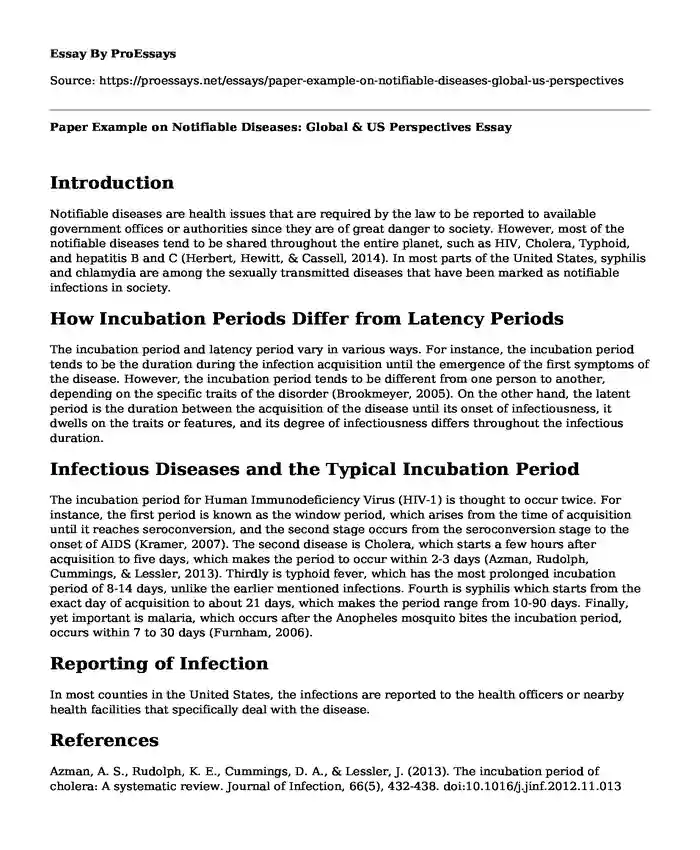Introduction
Notifiable diseases are health issues that are required by the law to be reported to available government offices or authorities since they are of great danger to society. However, most of the notifiable diseases tend to be shared throughout the entire planet, such as HIV, Cholera, Typhoid, and hepatitis B and C (Herbert, Hewitt, & Cassell, 2014). In most parts of the United States, syphilis and chlamydia are among the sexually transmitted diseases that have been marked as notifiable infections in society.
How Incubation Periods Differ from Latency Periods
The incubation period and latency period vary in various ways. For instance, the incubation period tends to be the duration during the infection acquisition until the emergence of the first symptoms of the disease. However, the incubation period tends to be different from one person to another, depending on the specific traits of the disorder (Brookmeyer, 2005). On the other hand, the latent period is the duration between the acquisition of the disease until its onset of infectiousness, it dwells on the traits or features, and its degree of infectiousness differs throughout the infectious duration.
Infectious Diseases and the Typical Incubation Period
The incubation period for Human Immunodeficiency Virus (HIV-1) is thought to occur twice. For instance, the first period is known as the window period, which arises from the time of acquisition until it reaches seroconversion, and the second stage occurs from the seroconversion stage to the onset of AIDS (Kramer, 2007). The second disease is Cholera, which starts a few hours after acquisition to five days, which makes the period to occur within 2-3 days (Azman, Rudolph, Cummings, & Lessler, 2013). Thirdly is typhoid fever, which has the most prolonged incubation period of 8-14 days, unlike the earlier mentioned infections. Fourth is syphilis which starts from the exact day of acquisition to about 21 days, which makes the period range from 10-90 days. Finally, yet important is malaria, which occurs after the Anopheles mosquito bites the incubation period, occurs within 7 to 30 days (Furnham, 2006).
Reporting of Infection
In most counties in the United States, the infections are reported to the health officers or nearby health facilities that specifically deal with the disease.
References
Azman, A. S., Rudolph, K. E., Cummings, D. A., & Lessler, J. (2013). The incubation period of cholera: A systematic review. Journal of Infection, 66(5), 432-438. doi:10.1016/j.jinf.2012.11.013
Brookmeyer, R. (2005). Incubation Period of Infectious Diseases. Encyclopedia of Biostatistics. doi:10.1002/0470011815.b2a04022
Furnham, A. (2006). The incubation period. Management Mumbo-Jumbo, 73-74. doi:10.1057/9780230626591_28
Herbert, S., Hewitt, K., & Cassell, J. A. (2014). Managing and reporting notifiable disease in the sexual health clinic. Sexually Transmitted Infections, 90(6), 452-454. doi:10.1136/sextrans-2013-051095
Kramer, I. (2007). What Triggers Transient AIDS in the Acute Phase of HIV Infection and Chronic AIDS at the End of the Incubation Period? Clinical Immunology, 123. doi:10.1016/j.clim.2007.03.287
Cite this page
Paper Example on Notifiable Diseases: Global & US Perspectives. (2023, Nov 19). Retrieved from https://proessays.net/essays/paper-example-on-notifiable-diseases-global-us-perspectives
If you are the original author of this essay and no longer wish to have it published on the ProEssays website, please click below to request its removal:
- Pressure Ulcer Paper Example
- Autophagy-Related Protein Expression Paper Example
- The Beauty of Beijing City Essay Example
- Research Paper on Decreased Quality of Life Affected by Diabetes
- Essay Example on Ethiopia: Scarcity-Driven Challenges in Rural Areas
- Essay Example on Person-Centered Care: Enhancing Health Care Performance
- Essay Sample on Breaking Barriers: Religion Working to Create Inclusion for the Disabled







